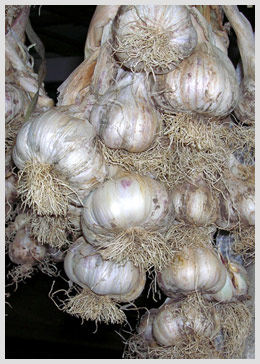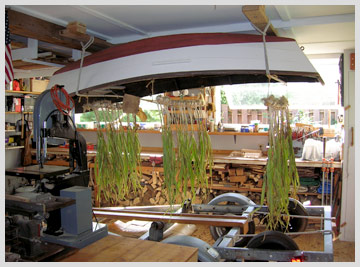Garden, Garlic - Lynette Walther
By Lynette L. Walther
 When foliage is dry, but not brittle, the garlic
When foliage is dry, but not brittle, the garlic
can be braided or the foliage cut away
to store the garlic. Photo: Lynette L. WaltherEach fall I plant a crop of garlic. My original garlic “seed” was a few bulbs of garlic I bought from a farmer’s market vendor, who explained how to plant them. I did exactly as he advised, and each summer I have been rewarded with a nice crop of savory garlic bulbs. Now I save the biggest and best bulbs to use when planting the following year’s crop. Each year my harvest supplies enough bulbs to braid up for holiday gifts. And, of course, there’s plenty to slow bake with a dollop of olive oil on top for spreading on homemade sourdough bread. It helps take the sting out of the end of summer just a bit.
Though the cured bulbs will keep for many months, I’m already using my garlic for seasoning dishes with the last of this year’s garden vegetables and herbs. Not only good, garlic is actually good for you. It is recognized as a potent medicinal herb with both antibiotic and antiviral properties. Louis Pasteur documented the bacteria-killing benefits of garlic back in 1858. Remember that when cold and flu season strikes and double up on the garlic intake. In the Middle East a clove of garlic under the lapel of a bridegroom is trusted as a potent aphrodisiac. And of course, we all know a string of garlic worn around the neck will help keep the vampires at bay—a sure remedy to apply come Halloween.
The best time to plant garlic is when it’s time to plant flowering spring bulbs. Garlic is another of those surprises to look forward to next year when things begin to thaw. There are two types of garlic, soft neck, which is best for braiding, and stiff-neck, which is reputed to have the best flavor. Both are planted in the fall to be harvested the following summer.
Here’s how to do it. Get garlic from a reputable seed source such as Johnny’s Selected Seeds (877-564-6697) or Seeds of Change (888-762-7333), or, of course, from your favorite farmer’s market vendor as I did. Varieties range in flavor from mild and sweet to hot and spicy. Sometimes grocery store garlic has been treated to prevent it from sprouting, so it is not a good choice for the garden.
To plant, separate the bulbs into cloves. Then plant each clove about two inches deep in rich, worked soil that has been amended with well-rotted manure or compost. The nutrients that are slowly released by the manure or compost ensures nice big bulbs.
Plant cloves about six inches apart. Then (this is the important part) mulch with a nice blanket of about a foot of loose hay. This will keep the garlic cozy all winter, and help prevent weeds come spring. It is important to keep the garlic weed free. So leave the mulch in place. The garlic will sprout through it, and then grow in its bed of hay all summer. Water as needed through the growing season.
Around June next year the garlic will send up “scapes.” Scapes are leafless flower stalks. Snap them off to help the plant's energy go into making bigger bulbs.
But don’t discard the scapes. They can be used in cooking. Just chop fine and use as you would garlic. By late July or early August the garlic leaves will start to turn yellow, signaling the time to dig the bulbs. Don’t wait until the leaves turn brown and dig carefully to avoid bruising or cutting the bulbs. Once it’s dug, allow the garlic to dry out of the sun with the leaves still attached. Air dry the garlic on a screen or hang to dry thoroughly.
 After carefully digging the garlic, it needs to be cured
After carefully digging the garlic, it needs to be cured
for storage. Leaving the foliage on the bulbs, quickly wash
away any dirt, and then use two sticks tied together
to hold the garlic so it can be hung to dry
out of the sun. Photo: Lynette L. WaltherTo dry a bumper crop of garlic, try this easy-to-fashion drying rack. Using two wooden tomato stakes or other long, skinny pieces of wood, lay the garlic along one of the stakes with the heads just above the stake and with the leaves trailing below. Place the second stake on top of the garlic, in line with the first stake. Tie at each end, leaving a loop of string a each end to hang the rack horizontally with the garlic heads facing up. Several of these simple racks can be hung in a small place when drying large amounts of garlic. When completely dry, either trim away the foliage or braid it. A good time to braid the garlic is once the green leaves have softened up and have started to dry. Then use the garlic as needed, saving the biggest bulbs to plant for next year’s crop.

 When foliage is dry, but not brittle, the garlic
When foliage is dry, but not brittle, the garliccan be braided or the foliage cut away
to store the garlic. Photo: Lynette L. Walther
 After carefully digging the garlic, it needs to be cured
After carefully digging the garlic, it needs to be curedfor storage. Leaving the foliage on the bulbs, quickly wash
away any dirt, and then use two sticks tied together
to hold the garlic so it can be hung to dry
out of the sun. Photo: Lynette L. Walther

Contributing Garden Editor Lynette L. Walther is the recipient of the National Garden Bureau’s Exemplary Journalism Award and the IABC Silver Quill Award of Excellence. She is a member of the Garden Writers Association. She gardens in Camden.
Related Articles
Share this article:
2023 Maine Boat & Home Show

Join Us for the Maine Boat & Home Show!
Art, Artisans, Food, Fun & Boats, Boats, Boats
August 11 - 13, 2023 | On the waterfront, Rockland, Maine
Click here to pre-order your tickets.
Show is produced by Maine Boats, Homes & Harbors magazine.















